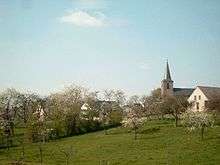Hesbaye

The Hesbaye (French), or Haspengouw (Dutch, in medieval Latin: Hasbania or Haspinga[1]) is a geophysical region in Belgium, mainly defining the southern part of the province of Limburg. Other parts are also found in neighbouring provinces: northwestern Liège, southeastern Flemish Brabant and northeastern Walloon Brabant. The Limburgish portion consists the cities of Tongeren, Sint-Truiden, Bilzen and Borgloon, the Flemish Brabant portion includes Tienen, Landen and Zoutleeuw, the Walloon Brabant portion includes Jodoigne and in Liège the towns Hannut and Waremme.
Geographically, Hesbaye borders on two similar regions of rolling hills: to the west Hageland, to the south, on the other side of the river Meuse (Dutch: Maas), the Condroz. To the north it borders on the flat sandy Campine (Dutch: Kempen) region. To the south and east it borders on the valley of the Meuse.
The fertile ground of this region's rolling countryside is mainly used for agricultural purposes, and in this context it is often divided into two divisions, with the boundary running through Sint-Truiden, Borgloon and Tongeren. The northern "Humid" (Dutch Vochtig) part has a high water table and many springs; it is by far the main fruit growing area of Belgium, as well as home to some of the most northerly vineyards in Belgium. The southern "Dry" division is somewhat more fertile and the ground water sinks more easily; in this region sugar beet, chicory, flax, rapeseed and grains (90% of which is wheat and barley) are cultivated.[2]
History

From the seventh century Hesbaye was an important fief in the northwestern marches of the Merovingian kingdom of Austrasia. It lay in "that region where the western foreland of the Eifel meets the south-western fringe of silva carbonaria, a woodland frequently mentioned in Frankish historiography."[3] The Merovingian county was consolidated from the old mark Haspinga of which the final -ga element survives in the -gouw of the modern Dutch name: Gau (plural Gaue) was an old Frankish term for a political division, equivalent in its etymology to the French pays.
Hesbania (confusingly spelled Hispania in some old documents) was perhaps set apart for Lambertus (born 640), son of Guerin, count of Poitiers (ca. 612 in Austrasia, – 677/87). It was mentioned in the division of territories between Charles the Bald and Louis the German in 870 in the Treaty of Meerssen, which specifically mentions that it had four counties at that time. Its exact boundaries are unclear but it may have stretched as far west as Leuven and the River Dyle. Judging from the ancient catholic Archdeaconry of Hesbaye, it may also have stretched to the east of the Maas river.[4]
Known counts of Hesbaye are Ingerman and Robert, who had shared ancestry. Robert the Strong, who founded the dynasty of the dukes of Brabant and the kings of France, also known as Capetians, seems to have descended from this family.
The fortunes of the line of Counts of Hesbaye were cemented when Ermengarde of Hesbaye (778 in Hesbaye — 3 October 818 in Angers), daughter of Ingerman, married Louis the Pious, son of Charlemagne.
In the 10th century, counties considered to have been within the country of Hesbaye included a County of Avernas (with its capital town in modern Hannut), a county which was itself called Hasbania, possibly between the Jeker River and the Meuse, and the County of Hocht (with its capital town in modern Lanaken). It is possible that Vliermaal played a role in a county also, because in later times it was a court town for the County of Loon. (Because the region may have been considered much bigger, it is likely that some counties in modern Flemish Brabant and Liège were also included, for example the County of Leuven.[5])
In 1040, the Emperor Henry III recognized a fiefdom called Hasbania as being under the prince-bishop Nithard of Liège. This Hasbania may have been one of the smaller counties within the Hesbaye, but it seems that the important County of Loon, which had formed out of the Counties of Avernas and Hocht, was considered to be held under it. Much later, the County of Loon was integrated it with the Prince-Bishopric of Liège.[6] Areas to the west of Loon came under the increasing power of the County of Brabant.
Today Hesbaye continues to be rural, with many small villages. Théo Brulard, La Hesbaye. Étude géographique d'économie rurale (Louvain) 1962, attempted to disengage the original aspect of the region from its open, deforested agricultural aspect of modern times, characterising Hesbaye as a human region rather than a natural one.
See also
- Hesbaye liégeoise
Notes
- ↑ Graesse, Johann Georg Theodor / Benedict, Friedrich: Orbis latinus, Lexikon lateinischer geographischer Namen des Mittelalters und der Neuzeit, Großausg. / bearb. und hrsg. von Helmut Plechl ..., Bd.: 2, E - M, Braunschweig, 1972, pg. 214
- ↑ "Vlaams infocentrum land- en tuinbouw - Zeg nooit Vochtig-Haspengouw tegen Droog-Haspengouw - VILT". Vilt.be. 2006-07-22. Retrieved 2014-07-10.
- ↑ http://www.badenhausen.net/harz/svava/MerovingSvava.htm
- ↑ Verhelst (1984 and 1985) "Een nieuwe visie op de omvang en indeling van de pagus Hasbania" Handelingen van de Koninklijke Zuidnederlandsche Maatschappij voor Taal- en Letterkunde en Geschiednis"
- ↑ Vanderkindere, Léon (1902), "9", La formation territoriale des principautés belges au Moyen Age (PDF), 2, p. 128
- ↑ Baerten (1965), "Les origines des comtes de Looz et la formation territoriale du comté", Revue belge de philologie et d'histoire, 43 (2): 468 and Baerten (1965), "Les origines des comtes de Looz et la formation territoriale du comté (suite et fin)", Revue belge de philologie et d'histoire, 43 (4)
External links
- Rolf Badenhausen, "Merovingians by the Svava?" Identifying Didrek of the Old Swedish Thidrekssaga with Theuderich, son of Clovis; includes Geographic glossary of placenames
| Wikimedia Commons has media related to Hesbaye. |
Coordinates: 50°45′N 5°18′E / 50.75°N 5.3°E